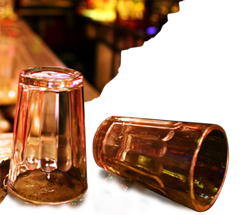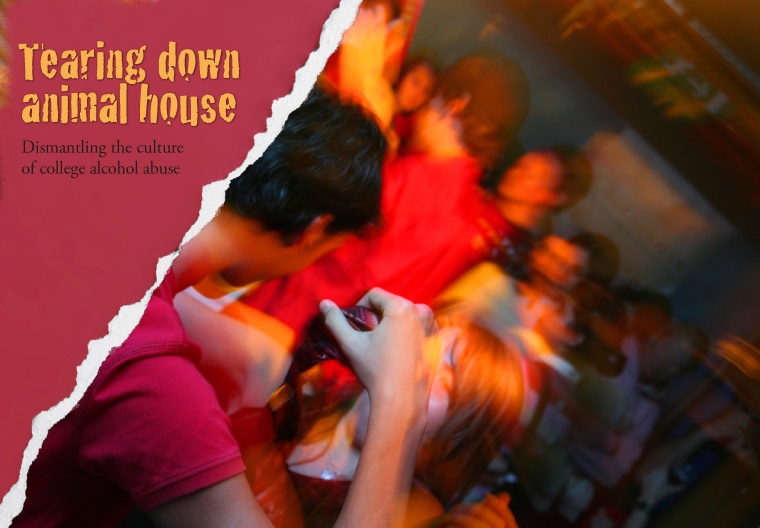| "Alcohol abuse is a problem on every college campus in America," says Chris Flynn, director of Virginia Tech's Cook Counseling Center, and Virginia Tech is no exception.
"The very nature of Virginia Tech has in it some of the environmental factors that lead to fairly high consumption rates," notes Vice President for Student Affairs Ed Spencer. These factors, including being a large university in a rural location with big athletics and a very active Greek system, all play a role in Tech's high-risk drinking rate of 56 percent of the student body--higher than the national average of 42 percent.
Every year, Virginia Tech's judicial system handles between 850 and 950 alcohol-related violations, whether drunk in public, driving under the influence (DUI), or underage drinking. A study showed that 34 percent of students who went to Schiffert Health Center with injuries could attribute those injuries to alcohol use. While most of these cases were just bumps and bruises, the outcome of high-risk drinking behaviors--defined as drinking five or more drinks for men or four or more for women in a two-hour time span--can have serious effects.
Serious falls, alcohol-related car accidents, and alcohol overdose are just some of the tragic consequences that can occur when students abuse alcohol. Every year, more than 1,500 college students nationwide die from unintentional injury due to alcohol-related factors, including alcohol poisoning, says Flynn.
Unlike alcohol dependency, which is defined as a chemical reliance on alcohol and causes withdrawal symptoms when the person goes too long without a drink, alcohol abuse is a pattern of behavior in which the person, while not dependent, engages in dangerous use of alcohol. This behavior can harm a person's health, relationships, academic work, or other areas of his or her life. A student is more likely to drive while intoxicated, sustain physical injuries from falling or getting into fights, have blackouts, miss classes because of hangovers, and have relationship troubles, which are the fallout of his or her conduct while drinking.
Although dependency is not unheard of in college students, says Flynn, far more students are abusing alcohol without being dependent.
AN OUNCE OF PREVENTION: ENCOURAGING LOW-RISK BEHAVIORS
Staff members at Virginia Tech's Campus Center for Alcohol Abuse Prevention are poised at the forefront of awareness and education about drinking on college campuses.
"I won't lie; we're not where we need to be," says Director Steve Clarke. He notes that while the number of high-risk drinkers hasn't changed over the past 10 years, the number of abstainers has increased from 15 to 30 percent.
The center's goal is to reach high-risk drinkers through a harm-reduction model, which focuses less on eliminating underage drinking and more on education and skill building to help prevent DUIs and hospital visits due to alcohol overdose or alcohol-related injuries and to reduce the frequency of hangovers and blackouts.
|
|
|
|
|
|
|

|
One of the most effective tools for reaching high-risk drinkers is motivational interviewing, a model focused on helping students examine their behavior and make better choices.
|
 |
|
|
|
The center focuses on educating students in high-risk groups: first-year students, Greek students, athletes, and those students facing alcohol-related violations within the university's judicial system. Additionally, it sponsors an online class called Alcohol-Wise that all freshmen must take or risk paying a fine at the end of the first semester.
While Cook Counseling Center is available for students to discuss a range of issues, including alcohol abuse and dependency and possible co-morbid issues, such as depression, anxiety, and bipolar disorder, professional staff members at the Center for Alcohol Abuse and Prevention provide psychoeducational opportunities for students in groups or individually.
One of the most effective tools for reaching high-risk drinkers, says Clarke, is motivational interviewing, a model in use at almost every college with an alcohol abuse prevention program. In this model, a facilitator meets the student in a nonjudgmental, two-hour session and takes him or her through the stages of pre-contemplation, contemplation, planning, action, and maintenance. Rather than teaching abstinence, the program focuses on helping these students examine their behavior and make better choices.
Jungmeen Kim, an assistant professor of psychology in the College of Science and director of the JK Life-span Development Lab, has made a careful study of self-worth and family relationships and their effect on alcohol and other substance-use patterns an important part of her research. She says that one of the worst things a person can do is to underestimate the value of counseling in helping to abate alcohol and other substance-abuse problems that stem from other life issues.
"People think too seriously about seeking help, even when the resources are available easily, even for mental issues that aren't viewed as serious--for example, breaking up with a boyfriend--but if that has a risk of increasing substance use, we should be able to help them not go that route," says Kim.
She adds that in late adolescence, ages 18 and 19, the prefrontal cortex--the part of the brain responsible for self-regulation and higher-level decision-making--is still developing. Not only can heavy drinking damage the developing brain, but students at this age are also more likely to act foolishly or not to consider the consequences of their actions. Because their brains are still developing, they're more likely to consider the immediate reward without reflecting on the negative consequences first.
|
|
 |
|
|
|
|
|
|
|
|
|
|
|
|
|
Taking on a symbolic name that stems from Greek mythology surrounding the purple stone--its name means "not intoxicated"--the Amethyst Initiative is a coalition of college and university presidents and chancellors who have signed a contract stating that they are willing and ready to facilitate debate on their campuses about lowering the drinking age from 21 to 18.
Among those who have signed the initiative is Virginia Tech President Charles W. Steger. Steger does not view signing the initiative as an endorsement of lowering the drinking age, but rather as a means to open up discussion that could address solutions to high-risk drinking on college campuses.
"The time has come for us to have a serious dialogue about underage drinking on college campuses across America. This is a national problem and deserves national attention," he says. "That is precisely why I signed the Amethyst Initiative--to spur a public discussion about how most effectively to decrease underage drinking, binge drinking, and drinking and driving in and around the campus community."
|
|
|
|
|
|
|
|
|
|
|
|
|
|
|
|
|
|
|
Clarke notes the importance of not focusing just on the individual but also on the community. Staff members at the alcohol abuse and prevention center also maintain an alcohol hotline where individuals can report issues, along with a Meet Your Neighbor program. Both programs are meant to help students living off-campus to coexist peacefully with town residents without alcohol causing an issue.
To compete with alcohol-related activities, the center sponsors late-night events, such as its Acoustic Café, Gobbler Fest, and alcohol-free tailgates at the Cranwell International Center.
STRIKING UP A CONVERSATION: CHANGING SOCIAL NORMS
"The No. 1 thing we can do is use an environmental approach beyond the individual, focus on the campus and surrounding area, focus on creating policies and laws, and on identifying over-serving of alcohol," says Clarke. "It takes time to do that. As long as we keep that dialogue going, I think we'll see a lot of progress."
Unfortunately, says Spencer, the issue of high-risk drinking on college campuses isn't just going to go away, and there's no "magic bullet" solution for the problem. "Sometimes I think we're just treading water to keep people from drowning, just to prevent it from being worse," he says.
Flynn blames part of the problem on what he calls the "Animal House mentality" often present on college campuses. "[Studies have shown that] college students always overestimate the amount of alcohol their peers are drinking," he says. When you help students to realize that their peers aren't drinking as much or as frequently as they had thought, says Flynn, you can help students to reassess their own drinking behavior.
It is unrealistic to think that most college students won't drink at all, Flynn says. "Most students come to college having already drunk alcohol in high school. The goal is to encourage low-risk behavior.
"I really believe it has to be a community effort to educate students, to get them to look out for each other, to involve the community. We all have to be aware of the consequences of alcohol and talk to our children and work with alcohol establishments in the community to not serve past the point of intoxication."
The dialogue about student drinking doesn't just take place at the national or local level, notes Spencer. Some of the most important discussions take place at the kitchen table. "I think we've got to partner with parents and get parents to partner with us. So much of this begins at home," he says, adding, "Now that we're getting more parents involved, I hope it improves. Only time will tell."
For now, staff members and administrators are engaging everyone, from students to parents to town citizens, in conversations about alcohol and how to curb high-risk drinking. There may be no quick-fix solutions, but the types of programs implemented at Virginia Tech and other higher education institutions are laying the groundwork for safer student behaviors when it comes to drinking. The problem may never go away, but every step toward diminishing it counts.
|



